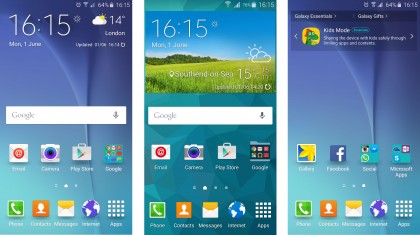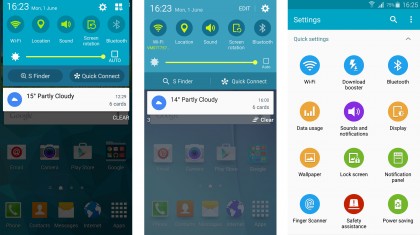Samsung Galaxy S6 vs Samsung Galaxy S5
Interface and performance
Both the Samsung Galaxy S6 and the Samsung Galaxy S5 now run on Android 5.0, which is the latest but one major iteration of Google's mobile OS.
Actually, the Samsung Galaxy S6 runs on the slightly more current Android 5.0.2, but it's the same basic OS, and the differences are barely perceptible. However, that's not to say that both handsets look and handle identically. They're very similar, but there are differences.
That's because they run subtly different versions of Samsung's custom TouchWiz UI, which sits atop the Android OS. The Galaxy S6 runs the newer version, as you might expect.

It's a shame the Galaxy S5 didn't get the exact same interface, but we suppose it comes down to Samsung wanting to differentiate its new phone. The Galaxy S6 interface is the more elegant and restrained of the two. Just as Samsung has smartened up its hardware act, so too it has applied a slightly more tasteful livery to the Android OS this time around.
The two UIs are functionally the same, but it's in the little touches that you see the differences: the default clock/weather widget that sits unassumingly at the top of the S6 home page rather than taking half the S5 screen up with a bright image. The slightly rounder, less fussy icon design. The simpler home screen transitions that scroll rather than appearing to come forward from the background.
The two phones have very similar drop-down notification menus, but the deeper settings screen is much better on the S6. On the S5 it's a sprawling mass of chunky icons, whereas Samsung has wisely pulled most of the options into an easier-to-navigate list format on the S6.

We'd still rather Samsung just dropped TouchWiz altogether and gave us a top notch phone with stock Android, but that's not going to happen any time soon. Comparing these two phones shows that Samsung is getting better every year. What's more, they're both pleasant, intuitive, modern systems that will be appreciated by hardcore and casual users alike.
Sign up for breaking news, reviews, opinion, top tech deals, and more.
All in all, the navigation experience is decent on both. Having said that, a combination of the slightly busier UI and inferior processing power means that the Galaxy S5 doesn't feel as smooth or snappy as the Galaxy S6.
The Samsung Galaxy S5 sports a Snapdragon 801 CPU backed by 2GB of RAM – a solidly capable off-the-shelf setup that's typical of a high-end phone of this vintage. However, Samsung bit the bullet and went with a much more interesting custom 64-bit Exynos 7420 CPU with 3GB of RAM for the S6.
It's a blazingly fast chip – perhaps the fastest around at the moment, at least in the world of Android. In our GeekBench 3 tests, the S6's average single-core result was 1495 compared to the Galaxy S5's 974 – a huge difference. That's echoed in the multi-core segment, where the S5's 3055 is soundly trounced by the S6's 5155.
Again, this is no disgrace for the older phone – the S6 is simply incredibly fast.
In real world terms, both phones can play modern high-end games just fine. You can discern the difference in performance in general navigation, as discussed, and you can also see it in the speed with which the Samsung Galaxy S6 camera boots up from the touchscreen.
With the newer phone, it's pretty much instantaneous. With the older phone, there's a noticeable black screen pause before the camera interface comes into view.
Neither of these phones is toting the newest Android 6.0 Marshmallow update yet. Both will be getting the latest Android, but even after it's been out for over half a year, Samsung is really struggling to get the software out to those who own the phones.
We'd expect by the time the Galaxy S7 comes around the update will be out, but there's still no gurantee. For the latest details on the Android 6.0 Marshmallow update check out our round-up.
We put the Samsung Galaxy S6 and Samsung Galaxy S5 head to head in a speed comparison. Who came out on top? Watch the video below to find out!
Battery life
TechRadar's reviews of the Samsung Galaxy S6 and Samsung Galaxy S5 paint strikingly different pictures of battery life. While the Galaxy S5's is described as "excellent," the Galaxy S6 is labelled "not good enough."
How did Samsung get it so wrong, and how does that bear out in a real-world head-to-head comparison?
The simplest point to make here is that Samsung dropped to a physically smaller battery with the Galaxy S6, clearly in the name of keeping that slinky new design. While the Galaxy S5 has a generous 2800mAh battery, the Galaxy S6 has a 2550mAh unit.
What's more, while the Galaxy S5's battery could be removed and replaced, the Galaxy S6 battery is fixed, so no carrying a spare around with you on a long haul flight.
Of course, few people actually do this anyway, and as mentioned, the Galaxy S6 is an easier phone to charge thanks to support for the two leading wireless charging standards. But the issue of that smaller battery remains, especially given the presence of a brighter, more pixel-packed screen, which is always the biggest power hog with any smartphone.

In practical terms, the Samsung Galaxy S6 isn't exactly bad. As we noted in the original review, you can get a full working day out of it, but you might have to hold off watching that HD video on the train home if you've been particularly active with it during the day. Now that's not uncommon in a modern smartphone, but when the Galaxy S5 can clear a whole day comfortably with room to spare, you see the issue.
Interestingly, in my own video tests, which involved playing a 90 minute 720p video with the screen brightness cranked right up, the two phones performed identically. Both ate up just 13 percent of a full charge on average.

This suggests that Samsung has worked wonders to make that brighter, sharper screen work more efficiently. It also shows how flexible and efficient that Exynos 7420 CPU is, and emphasises how well it's cut out for media playing.
Samsung's custom chip is built using a much smaller production method than the Galaxy S5's Snapdragon 801 – 14nm versus 28nm – which means that it generates less heat, and can do a lot more with the same power. It's also octa-core, so it divides tasks intelligently between two sets of four cores according to requirements.
In other situations, however, I found that the Galaxy S6 battery fell way behind. After an afternoon out spent snapping photos with both phones for this comparison piece – a four hour trip that involved travelling to some nice RHS gardens and taking around 20 identical pictures – I found that the Galaxy S6 had just 60 percent battery life left in the tank, while the Samsung Galaxy S5 had 79 percent.
You could argue that the Galaxy S6 has a much more advanced camera than the Galaxy S5, and that the viewfinder was rendering the live images with much more detail. But this explains why we're so irritated that the Galaxy S6 battery doesn't perform as well as its predecessor. Samsung has crammed some phenomenal components in, but it hasn't given them the power plant to fully match their capabilities.
It didn't need to be this way, if only Samsung had added a couple of millimetres onto the phone's waistline and gone with a slightly bigger battery.
Meanwhile, the continued strong performance of the Galaxy S5 – a well-worn handset that's been in frequent use at TR towers over the past 12 months, let's not forget – shows that its robustness runs deeper than its rather functional shell.
Current page: Interface, performance and battery
Prev Page Design and display Next Page Media and the essentials
Jon is a freelance journalist who has been covering tech since the dawn of the smartphone era. Besides TechRadar, his words and pictures have appeared in The Telegraph, ShortList, Tech Advisor, Trusted Reviews, Expert Reviews, and more. He largely covers consumer technology, with a particular focus on smartphones and tablets. However, he's also been known to dabble in the worlds of entertainment and video games.